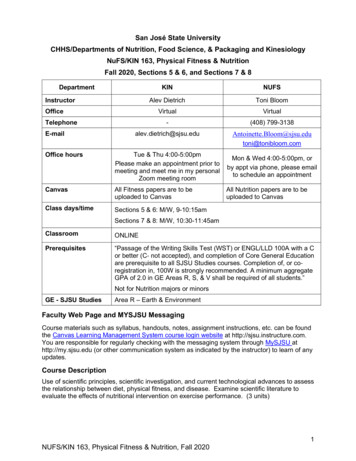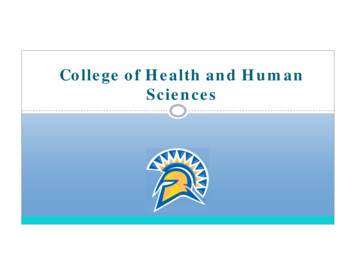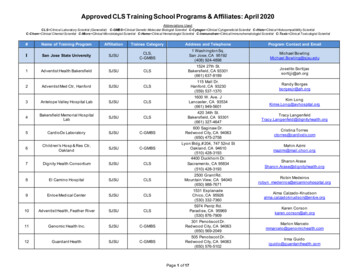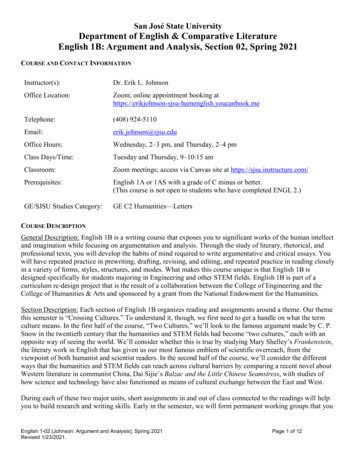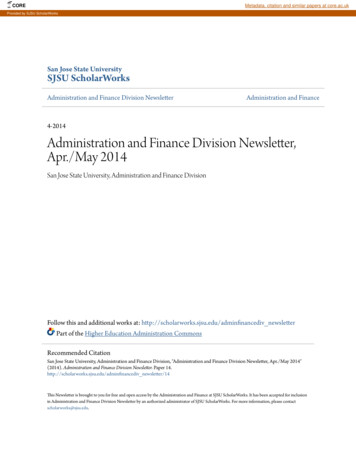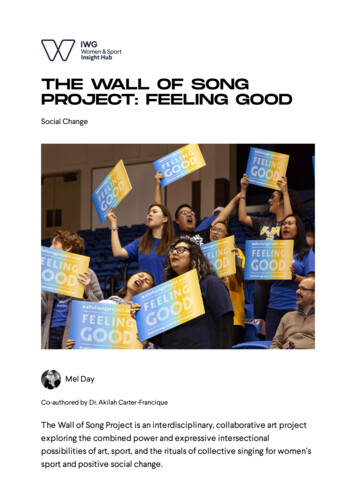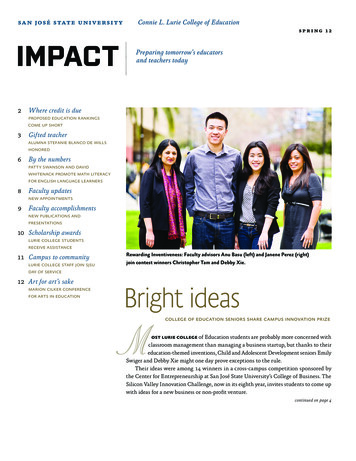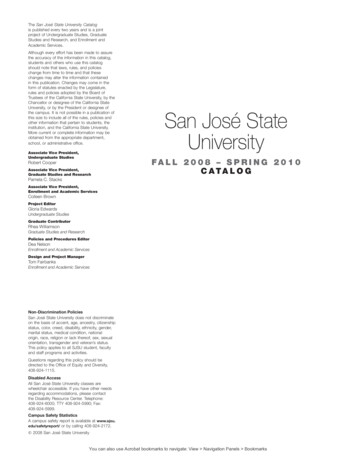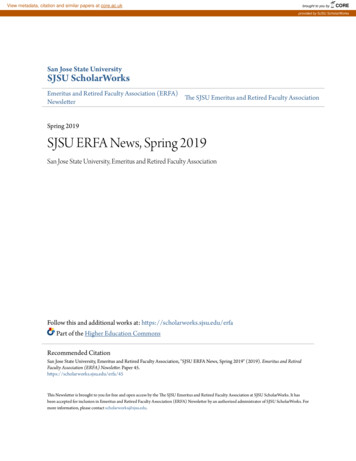
Transcription
View metadata, citation and similar papers at core.ac.ukbrought to you byCOREprovided by SJSU ScholarWorksSan Jose State UniversitySJSU ScholarWorksEmeritus and Retired Faculty Association (ERFA)The SJSU Emeritus and Retired Faculty AssociationNewsletterSpring 2019SJSU ERFA News, Spring 2019San Jose State University, Emeritus and Retired Faculty AssociationFollow this and additional works at: https://scholarworks.sjsu.edu/erfaPart of the Higher Education CommonsRecommended CitationSan Jose State University, Emeritus and Retired Faculty Association, "SJSU ERFA News, Spring 2019" (2019). Emeritus and RetiredFaculty Association (ERFA) Newsletter. Paper 45.https://scholarworks.sjsu.edu/erfa/45This Newsletter is brought to you for free and open access by the The SJSU Emeritus and Retired Faculty Association at SJSU ScholarWorks. It hasbeen accepted for inclusion in Emeritus and Retired Faculty Association (ERFA) Newsletter by an authorized administrator of SJSU ScholarWorks. Formore information, please contact scholarworks@sjsu.edu.
SPRING 2019 VOLUME 32 NUMBER 3SJSUERFANewsInside . . .Nils Peterson and Gene Bernardinireveal some important life lessonsthey learned in the Fourth Grade;meanwhile, Lonna Smith learned,in London, that Englishmen aresometimes able to relax their stiffupper lips. (Pages 4-6)A Newsletter of the San Jose State University Emeritus and Retired Faculty AssociationLeaving a Legacy:Your SJSU Biography in ScholarWorksBy Joan Merdinger (Social Work)After the founding of SJSUERFA in 1986 (then called EFA—Emeritus Faculty Association), itsExecutive Board initiated an effortto chronicle the accomplishmentsof SJSU retired faculty membersand create a legacy for them. Theproject culminated in a sizeablecompendium that took ten years tocomplete, entitled the Biographiesof Retired Faculty, San José StateUniversity, 1997: A project of theEmeritus Faculty Association ofSan José State University. It wasover 450 pages long and includedthe biographies of 170 currentfaculty and a list of names, datesand departments of 179 otherfaculty who had previously passedaway. It is still available in ourUniversity Library.Following that initial effort,in 2009, our Board, under theleadership of then-ERFA PresidentPat Nichols, decided to undertakea new effort to update thebiographies of SJSU faculty whohave retired since the originalbook of Biographies. With newcomputer technology we couldclearly upgrade the process tokeep a running list of retirees intoperpetuity. Thus, a Bios pagewas created on our SJSU-ERFAwebsite and ERFA members wereencouraged to submit their ownbiographies, with a picture, tochronicle past accomplishmentsand inform colleagues of theircurrent interests and projects. TheBios page currently lists some 80ERFA members.Bringing us up to the current era,the SJSU Library has adoptedScholarWorks as the institutionalrepository of the research andcreative works of all SJSU faculty,students and staff. And incollaboration with the ERFA Board,the University Library has createda new area of ScholarWorks,dedicated to SJSU Emeritus andRetired Faculty, entitled “TheEmeritus and Retired FacultyBiographies.”Working with the UniversityLibrary on this major enhancementof ScholarWorks, we haveprovided an opportunity for youto create, edit and update theinformation you would like toinclude about your professionallife as a faculty member at SJSU,and any personal information thatyou would also like to include.As of December 2018, there aremore than 30 Biographies of ERFAmembers on the ScholarWorkswebsite, which greatly increasesthe visibility of the contributionsand achievements of ERFAmembers. Please see this link forBiographies of your colleagues:https://scholarworks.sjsu.edu/erfa bios/Included in this Newsletter isa flyer with additional detailsabout how to get started on yourBiography in “The Emeritus andRetired Faculty Biographies”website, if you are interested inparticipating. Here is the link toget started: http://bit.ly/ERFAbiosThis is an important opportunityfor you, as a retired facultymember, to leave as a legacy,your contributions that you madeto SJSU. Please note that thiscurrent ScholarWorks project– along with all prior Biographiesprojects that have been sponsoredby the ERFA Board – is completelyvoluntary for all ERFA members.We hope that you join us in thisnew endeavor.calendarWednesday, April 3, 2019Friday, May 10, 2019Spring ExcursionSpring LuncheonOAKLAND MUSEUMLARRY HANCOCKOpera San JoseLocation: The Villages(See notice, Page 2)(See Enclosed Flyer)
SPRING 2019Page 2SJSU ERFAUniversity and Academic Senate NewsNewsChancellor’s Office, SJSU Academic Senate reach compromiseBy Susan McClory(ERFA Senate Representative)It is my honor to be allowedthe opportunity to return to theAcademic Senate as the ERFArepresentative in the place of PeterBuzanski, the longest servingrepresentative to that body. I don’tknow that anyone can replacePeter, but I will do my best to keepyou informed about the importantissues being taken up there.I previously spent 12 years onthe Academic Senate as both afaculty member and as Vice Chair,and I believe that what makes ourAcademic Senate special is itsdedication to shared governance.Unlike similar bodies on many othercampuses, ours includes all threeimportant groups in our university:1) faculty representatives from eachof our Colleges; 2) administrators;and 3) students.At the Academic Senate meetingon February 11, a considerableamount of time was spent discussinga draft of a new ten-year StrategicPlan for the University. After muchconsultation, five themes for theSJSU ERFA Officers, 2017-18President -- Elba Maldonado-ColonVice Pres. -- Chris JochimSecretary -- Celia BakkeTreasurer -- Abdel El-ShaiebMembers at Large -- Carmen SiglerBill McCrawJo Bell WhitlatchAcademic Senate -- Susan McCloryPast President ---- Ji-Mei ChangEx Officio MembersNewsletter Gene Bernardini (Editor) and Clyde Lawrence (Layout/Design)Membership Wayne SavageConsolations Jill CodyActivities Dolores Escobar-Hamilton ArchivistCelia BakkeLonna SmithCSU-ERFA Reps Don KeeseyJackie SnellBob WilsonJoan MerdingerProgram Committee: Carmen Sigler, Barbara Conry, BillMcCraw, Jo Bell Whitlatch and Mary Jo Gorney-MorenoCSU ERFA State Council Delegate-at-Large--David ElliottWebmaster--Carol ChristensenSJSU ERFA OfficeMacQuarrie Hall 438Demail: celia.bakke@sjsu.edu Telephone: (408) 924-2478Visit the SJSU ERFA Website at www.sjsu.edu/emeritusfacultyViews and opinions expressed in this SJSU ERFA Newsletter are thoseof the contributors and do not necessarily reflect the position of the editor or of San Jose State University.planning and vision emerged: 1)engage and innovate; 2) excel andlead; 3) grow and thrive; 4) connectand contribute; and 5) rebuild andrenew.The other major issue that theAcademic Senate has been dealingwith is our general education areaD, which covers the social sciences.Currently, our requirement is thatstudents must take a class fromeach of three subcategories: D1—Human Behavior; D2—ComparativeSystems; and D3—Social Issues.The Chancellor’s Office hasnotified us that, by having thatrequirement divided into threesub-categories, we are out ofcompliance with Executive Order1100. After much work by the AVPfor Undergraduate Studies, we havereached a compromise with theChancellor’s Office that allows usto keep our three sub-categories,but we must allow students to takethree courses from at least twoof them. This compromise wasapproved with a resolution that wasamended to include a statement ofwhy we made the change.Springis in theAriaYou’ll receive your SpringLuncheon flyer in the mail inApril, containing details andreservation forms. Our speakerwill be Larry Hancock, thewell-known Director General ofOpera San Jose. A lively andentertaining speaker, he’ll tellus how he became enthralledwith the world of opera andwill recount his experienceswith singers, audiences andperformances. You’ll not wantto miss this one.
SPRING 2019SJSU ERFANewsIn Memoriam Jose Villa (Social Work, ’92),died peacefully at his home inLa Villita, NM, on June 27, 2018,at the age of 87. Born in NewMexico to immigrant parents, heworked the cotton and broomcornfields of Eastern New Mexico andWest Texas with his siblings. Hewent on to earn a BA from theUniv. of New Mexico (1960), anMSW from Arizona State Univ.(1968) and an MA (ED.) fromSJSU (1975). He was proud ofbeing appointed the first facultymember of the newly establishedSchool of Social Work at SJSU,in 1969. Jose was a dedicatedactivist on behalf of MexicanAmerican, Chicano and otherunderrepresented minorities. AtSJSU he started the first graduatelevel program in MexicanAmerican Studies and, in 197173, worked to introduce bilingualeducation into the schools ofthe SJ Unified School District.Although he published articles,his main focus was on mentoringothers in community organizing.He met Jimmy Carter and HubertHumphrey along the way, andworking with local politiciansto seek changes in policiesand legislation, he won severaldistinguished service awards.After retiring from SJSU in 1992,he moved back to New Mexicowith his wife Clare and beganrestoring an old adobe home forhis family with the help of theireight children. He worked to bringa Habitat for Humanity affiliate toLos Alamos and Espanola andto encourage parents in the localschool district to support theirchildren in getting an education. Richard Whitlock (HealthScience, ’92) passed away onNovember 6, 1918 at the ageof 88. Born in Chicago, IL, in1930, he took a BS degree fromUtah State University (1951),an MA from the Colorado StateCollege of Education (1955),and his Ed.D from the Universityof Oregon (1963). He beganteaching at SJSU in 1957 andwas a founding member of theHealth Science Department. Hisleadership qualities led him intoadministrative duties, wherehe became Acting Dean ofUndergraduate Studies in 1969,and then Dean from ’71 to ’78. Hehad a penchant for organizationand advocated transparency inpolicies and procedures. Hewas described by colleaguesas knowledgeable, with a “nononsense, low key personality.”But he could be witty and had asense of humor. At a meeting, acolleague once requested a colorprinter from the department Chair,and Richard helpfully taped acolored pencil to the wall abovethe Chair’s desk, with an arrowand a note that read: “ColorPrinter.” He published a booktitled School Health Problems(1969), an article on “InstructionalTV in Health Education” (1966)and wrote several comprehensivepamphlets for students and facultyas Dean. He loved to travel,especially to Northern Italy andto the National Parks with hischildren. He leaves behind hiswife, Virginia Vanucci Whitlock, hisseven children, grandchildren andgreat-grandchildren. Harris Martin (History, ’88)passed away recently (no dateavailable) at the age of 95. Harriswas born in Tokyo, Japan, onSeptember 23, 1923, of Americanparents. He was nicknamed “Jish,”a name derived from the Japaneseword for “earthquake,” for the 7.9earthquake that devastated Tokyotwo days before he was born. Helearned to speak Japanese as aboy and later attended StanfordUniv., earning his BA (1947), MA(1949) and Ph.D (1959), majoringin Japanese history. As a juniornaval officer at the end of WWII, he was in Japan in the final,Page 3fateful weeks of August, 1945,serving as an interpreter for bothan American Marine BrigadierGeneral and a Japanese NavalLt. Commander. They were onthe first American ship to map theminefields outside the entrance toTokyo Bay, in preparation for thesea landings into Japan. He saidthat experience led to his decisionto teach history. He spent the next30 years in the Naval Reserve,serving in both WW II and Korea.Meanwhile, he taught JapaneseHistory at SJSU, offered courseson Modern Japan at the MontereyInstitute for International Studiesand was an active member ofseveral Asian Studies associations,attending conferences andpresenting papers. Tall,handsome, with a full head ofwhite hair and a Van Dyke beard,he looked “the spitting image” of“Commander Whitehead.” He wastold by President John Wahlquistto shave off the beard--and herefused. Wahlquist backedoff and Jish became a minorcelebrity on campus for expandingfaculty rights. Married to his wife,Barbara, for over six decades, theyhad four children and presumably,several grandchildren. Harry Powers (Art & Design,’91) passed away on December3, 2018, surrounded by his family.Harry was a prolific artist whosework, spanning over half a century,was shown in Europe, Australiaand the United States. He earnedan undergraduate degree fromSan Jose State College and agraduate degree in painting andart history from Stanford Univ. Heacquired a deep interest in history,cosmology, geology and a lastinglove of literature, classical musicand opera. During his thirty yearsof teaching at SJSU, he inspiredstudents with interests close tohis heart: music, light, ancientcultures. He drew from a variety(Continued on Page 6)
SPRING 2019Page 4SJSU ERFARemembrance of Things PastNewsSharing memories with our members . . .Memories from Childhood:Early School LessonsBy Gene Bernardini (Humanities)The elementary school inBuffalo, NY, where I spent thethird and fourth grade was anurban public school in an almosttotally black neighborhood. Wemoved there in 1942, whenwartime jobs in the nearbyshipyards had opened up andhousing was scarce. The schoolitself was an old red brickbuilding with tall, sash windows,and the inscription chiseledover its entrance identified itas Public School 32. Like mosturban schools, it was completelysurrounded by chain link fencing.There were a few outlyingclassrooms in the rear, includinga gymnasium, which we repairedto in the winter when the deepsnow made it impossible to playoutdoors. The building was warm,we were full of energy and thebreak from classes made it fun.Inside, we ran relay races fromone end of the floor to the other,or shinnied up and down thickropes hanging from the ceiling,or formed circles to play dodgeball. The only drawback: I hatedhaving to dress and undressin the locker room. My mothermade me wear long-johns thatextended from neck to ankles,trap-door included. Most of theother boys didn’t wear them andI was embarrassed. I felt like alittle old geezer and thought theother boys might be snickering orpitying me. The day my motherfinally gave in to my pleading andlet me wear jockey shorts was aday of liberation—I was on myway to becoming a man.Despite being a ghetto school,the educational standards atP.S. 32 were surprisingly high.The New York school system hadmandated requirements that wereapplied equally to every publicschool in the state. The systemwas like those in Europe whereit was famously said that on aTuesday morning in the secondweek of any month, all the childrenin France were receiving the sameclassroom lessons in their grade.As a result, our neighborhoodschool in Buffalo was providedwith educational programspresumably on a par with allothers in the state. At the end ofhigh school, students throughoutNew York had to pass a RegentsExam in order to receive their highschool diplomas. The system thenwas strict and uncompromising.One of the teachers I stillremember fondly was an elderlywoman who resembled astereotypical spinster: she wastall, thin, straight-backed, and,yes, had grey hair tied in a bun.Though she looked imperious,her attitude toward students wasbenign and she was respectedby all. She had a slight sense ofhumor and once told us during agrammar lesson that most peoplemisused the word “got.” It’s adifficult word to use correctly, shetold us, and to avoid confusionwe should never use it. “Justtake the word ‘got,’ and put it outthe window. Let it hang from theledge,” she said, “then shut thewindow and forget about it.” Wewere advised to use “gotten”instead.I heard classical music for thefirst time ever, in her fourth gradeclass. The only music I heard athome were commercial jingles onthe radio. But an hour or so eachweek, she would play records ofserious works until they becamefamiliar to us. That is where I firstheard Grieg’s Peer Gynt Suite—and the motif from “In the Hall ofthe Mountain King” stayed with mefor the rest of my life.When our family moved tosouthern California one year later,I immediately felt the contrast, thelack of educational seriousnessand rigor in class. The lessonsseemed easy and were impartedin a casual manner. In those days,when we were expected to standup and read aloud from a bookin class, I was surprised when ateacher asked me, afterwards,how I had learned to read sowell. Of course, I had no idea,but I soon began to suspect thatCalifornia schools were at leasthalf a grade below New Yorkstandards. At the time, I naivelyassumed that this discrepancywas temporary and by high schoolwe’d get caught up. That neverhappened.Discipline was another differenceI discovered between the twosystems. On one occasion at P.S.32, I had been rough-housing witha classmate in the hallway andwas collared by a teacher andsent to the principal’s office. Thiswas the first and only time thathappened and I was nervous, notknowing what to expect. WhenI entered the principal’s office,a secretary told me to sit on abench against the wall where ablack boy was already sitting. Heseemed morose and uninterestedin conversation, so we sat togetherin silence, awaiting our fates. The(Continued on Page 5)
SPRING 2019SJSU ERFANewsRemembrance of Things PastPage 5Sharing memories with our members . . .A Proper GentlemanBy Lonna SmithIt was rush hour in London, andtraffic was exactly as you wouldexpect, even if you’ve never beento that city. My friend, Linda, andI were on a bus inching its waydown the street from TrafalgarSquare to wherever it was we weregoing. On this particular bus,we were sitting on a bench seatwith our backs to the wall facingpassengers sitting across from us.Although riding on a bus inthe heart of London was a newexperience for me, it was familiarterritory for Linda. Born andraised in England, she spent herundergraduate college days inLondon and knew the city well.And even though she had livedmore than half her life in theAlmaden Valley, in many ways(Continued from Page 4)England was stillprincipal, a middle-aged woman,home.soon came out and seeing theWe sat chattingboy, said, “So, you again! Howaway, but I was alsomany of times have you beenindulging in a bit ofhere?” The boy sat stone-facedpeople watching. Oneand said nothing. She had himpassenger fascinatedstand up, put out his hands and,me, a quintessentiallyswiftly producing a wooden rulerEnglish gentleman.from out of nowhere, broughtHe sat directly acrossit down with full force, twice onfrom us dressed in theeach hand. The sharp, “Crack!most proper threeCrack!” surprised and shockedpiece suit. Besideme. The boy didn’t flinch andhim was his brolly,his face remained impassive.even though the sunHe’d been through it before andwas bright that day,took it stoically. She banishedand on his lap sittinghim from the office with a newmost primly atop hiswarning of worse to come—andbriefcase was hisbriskly turned to me. Having justbowler. His face wore a mostvisualized my impending fate, myeyes began to fill with tears. Sheserious expression, no doubtasked what I had done, and afterprompted by overhearing Linda’stelling her in a quavering voice, her and my conversation. Knowingface softened. She extracted aour accents would be clues topromise to behave myself and sent our identities, I wondered whatme back to class. Apparently myhe thought of an upstandingreaction to what I had witnessedEnglish woman talking with awas punishment enough.flighty American. Judging from hisThat day, had I known my familystern expression, I surmised hiswould soon be moving to thethoughts were not approving.West Coast, to a school with lowerThe bus crept along, squeezedstandards and less rigor, I thinkin among the taxis and other cars.I’d have begun singing “CaliforniaThere wasn’t much to see fromhere I come . . . .”my vantage point, just the sides ofEarly School Lessonsbuildings, the plethora of vehicleson the road and, of course, thesolemn Englishman across fromme.But as the bus slowly rolledinto an intersection, somethingextraordinary happened that I willnever forget. Never taking hiseyes off me, the oh-so-properEnglishman, slowly leaned overto one side to reveal the view heblocked. As the upper part of hisbody angled to the right a tiny,droll smile appeared on his face.And there through the windowbehind him was a magnificent viewof Big Ben!I broke into a wide grin, and evennow, so many years later, I smilethinking of the sweet gesture thislovely man gave to an Americantourist. I mouthed, “Thank you,”and as the bus left the intersectionand the man returned to hisupright position, he nodded. Thenhe lifted his bowler, opened hisbriefcase, took out a newspaperand began to read.
SPRING 2019Page 6In Memoriam(Continued from Page 3)of experiences: camping as a boywith his father, contemplatingthe starry sky at night; becominga photo-lithographer in the USNavy; traveling to Italy wherehe observed the play of lighton architectural surfaces;teaching in England where heviewed the Neolithic remains ofancient cultures; and conductingworkshops in Australia wherenative rock paintings inspireda large body of bronze andaluminum sculptures. He workedwith plastics, metal, oil paintingand wash drawings. He was agentle, shy man with a sweetdisposition and a perpetual smile.He leaves behind his artist wife,Lynn, and his two children, Murrayand Kiki. James Lima (ElectricalEngineering, ’88), “Bud” tohis friends, passed away onJanuary 20, 2018. Bud wasborn in Oakland in 1924 andafter graduating from LivermoreHigh, he was drafted into WW IIand served in the Signal Corps,where he received his trainingin Electrical Engineering atMIT. He married his high schoolsweetheart, Virginia, in 1944, andafter his discharge they moved toWillow Glen where Bud workedin his father’s business, runningthe Garden Theater. They boughta house, had three children andwhen Virginia began teaching fulltime, Bud attended San Jose StateCollege, earning his Bachelor’sand Master’s degrees in ElectricalEngineering. He was hired byIBM, while teaching part time atSJS. He later attended Stanfordand graduated as an ElectricalEngineer, alongside his son, Paul,both graduating from the samedepartment at the same time.Soon after, Bud went back toSJSU, became a full professor andAssoc. Dean for Academic Affairs.He helped form a new departmentof Computer Engineering andbecame its Chairman the yearbefore he retired in 1988. He andVirginia spent the next 15 yearstraveling and fishing their wayaround the US and Canada in theirtrailer. Virginia passed away in2003 after 59 years of marriage,and Bud is survived by his threechildren, six grandchildren and tengreat-grandchildren. Richard Post (Mathematics)passed away on January 14,2019, at his home in Carmelsurrounded by his loving family.Born in Brooklyn, NY, in October,1930, Richard attended BrooklynTechnical High School and later,Syracuse University, graduatingwith a degree in Mathematics.He earned his Ph.D at ColumbiaLost RitualSJSU ERFANewsUniv., specializing in statisticsand probability, and in 1957 hemoved west to teach at SJSCollege. While teaching, heconsulted for Lockheed, GeneralElectric, Lawrence LivermoreNational Laboratory and StanfordResearch Institute. He eventuallyjoined Intel Corporation full time,where he worked on statisticalprocess controls during Intel’sglobal expansion in the 1980s.Richard was a lover of competitiveathletics and served as SJSUFaculty Athletic Representative formany years. He is survived by histhree children, six grandchildrenand two great-grandsons. Hiswife Joan, to whom he was deeplydevoted, predeceased him.By Nils PetersonWhat I learned in fourth gradedust dances in a sun-streaksnow falls from then to nowreal ink in your inkwell changes thingsThroughout grades 1 to 3 we sat at desks (I think they were all thesame size no matter what size we were) that had a round hole in the upperleft hand corner. It was where the inkwell was supposed to go. In the fourthgrade the hole was filled with an inkwell. In a few weeks, the wells were filledwith black ink and we were supplied with pens. The days of the pencil wereover for the serious work of writing. Now things could be blotted but noterased. The world had changed.The potential for mess was enormous, particularly if you were aclumsy boy. The girls all seemed so ably neat. My pen seemed designed tospread puddles of ink across the page. My handwriting was impossible. Theletters of my words wandered all over never in a straight line. The pen left atrail of splotches like the crumbs Hansel and Gretel left behind in the woodsto find their way home. But no crow came to eat them. They were indelible.(In the fifth grade, I thought I’d found the secret. The girls all seemed to writesmall letters while my huge ones wobbled over the page. So. I took my bigsloppy writing and made it small like theirs rendering it even more illegible.)But the big lesson was that we were growing up and the worldinsisted on giving us responsibilities whether we wanted them or not.I find myself thinking that the ball point pen made the world easier,but maybe not better. It was really exciting to have the grown-up world putink in your inkwell.
SPRING 2019SJSU ERFAChat Room . . .NewsPage 7Special news from and about our members.Edited by Gene BernardiniThis edition contains news about travels and activities taken from the membership renewal forms. Members are invited to send additional newsabout themselves to Gene Bernardini at geebernard@comcast.net or by snail mail at 775 Seawood Way, San Jose, CA 95120 Dennis L. Wilcox (Journalism‘05) and his wife, Marianne, visitedthe Emerald Isle of Ireland on afive-week ramble from Cork toBelfast and Dublin to Galwaylast August/September. Dennissays, “Ireland is really 40 shadesof green and everyone we metseemed to have a relative in theU.S., thanks to the massive Irishdiaspora in the 1850s after thegreat potato famine.” He alsonoted that “Pub life is a major partof the Irish DNA, which requireda lot of research and sampling onmy part.” Brent Heisinger (Music, ’96) willbe presenting one of his musicalcompositions, titled Statement, onthe SJSU campus this spring. Thepiece reflects his experience in thelate 60s, a time of social turmoilwhen student protests often tookplace on 7th St., just outside hisoffice. The agitation on campusover Vietnam, Farmworkers’strikes, Women’s Liberation,Black Power and other issues,evoked rage, hatred, distrustand instability. The FBI choseto monitor the angry rallies andspeeches from the windows of hisoffice. Brent writes, “Statementis a musical/dramatic discourserepresenting that scenario.Dissonance, shouting, and thesinging of Gregorian chant arecalled for in an intense formatrepresenting humankind’s cycleof peace and war.” He believesthe composition is unique andexpects it to leave an indelibleimpression. It was commissionedby the California Band DirectorsAssociation, and at its premier,the conductor called it “one ofthe finest pieces of contemporaryband literature written today. Itreflects the turmoil of today’ssociety.” The program will takeplace in the SJSU Concert Hall, at7:00 pm, April 10th. Susan Murphy (Nursing, ’01)continues to lead Courage &Renewal Retreats on aging, alongwith other meditation retreats.She and her husband Michaeltravel regularly on trips that includearcheology, medieval history andcathedrals. Some favorites werean Orkney tour to see 3000-yearold excavations; walking ancientcity walls in Wales; and visitingcathedrals in York, UK. They’vesung with choral groups for yearsand a special trip included singingwith the Russian choir, Slavyanka.And closer to home, they enjoyeda birdwatching tour in Yellowstone. Howard Combs (Marketing,’17) will be a Visiting Professorat Chulalong Korn University inBangkok, Thailand. He’ll teachthere during the spring semesterswhile he continues to FERP atSJSU. Susan Myers (Education, ’09)went off to Cuba this past Octoberwith her husband, Michael. Justbefore leaving, she wrote: “Wewill be a tour group of two of us,staying in family homes. We’relooking forward to our adventure.”Charlene Archibeque (Music,’05), sadly, lost her life partner,Robert Melinkoff, last October 29,after a long illness. He practiceddermatology in San Jose until hisretirement in 2012. They, too,traveled the world together foryears and enjoyed sharing therich cultural life offered by the BayArea. Phyllis Keesey (Assoc. Member)passed away on January 29after a long battle with cancer.Phyllis was for many years aSpecial Education teacher in theOak Grove school district. Afterretirement, she enjoyed reading,traveling, and devoting time tocharity work. She is survived byher husband, Don (English, 2001)and their three children and fourgrandchildren. Nils Peterson (English/Humanities, ’99) and his wife,Judith, have moved to Seattle,Washington. Judith has medicalissues that made it seem wiseto live in senior housing and tobe near a daughter. Nils’ says,“We have a nice apartmentand are thousands of booksand many possessions lighter.Mostly that seems good. I thinkfor our daughters—all good.”The Petersons’ new contactinformation is in the 2018-19Membership Directory.SJSU-ERFA Board requests Constitution changeAt our annual Business Meeting,which takes place during theSpring Luncheon on May 10,the members in attendance willbe asked, as usual, to ratify thecandidates recommended fornext year’s ERFA Board. In theNovember issue of the Newsletter,we solicited nominations forcandidates from our membership(with a deadline of February 1,2019). At the upcoming meeting,the Board will also be requestingapproval for two changes in theERFA Constitution to simplify theprocess.The section of the Constitutionthat is at issue currently reads:ARTICLE VII. NOMINATIONSIn a timely manner and with theadvice of the Executive B
SJSU ERFA News, Spring 2019 San Jose State University, Emeritus and Retired Faculty Association Follow this and additional works at:https://scholarworks.sjsu.edu/erfa Part of theHigher Education Commons This Newsletter is brought to you for free and open access by the The SJSU Emeritus and Retired Faculty Association at SJSU ScholarWorks. It has
